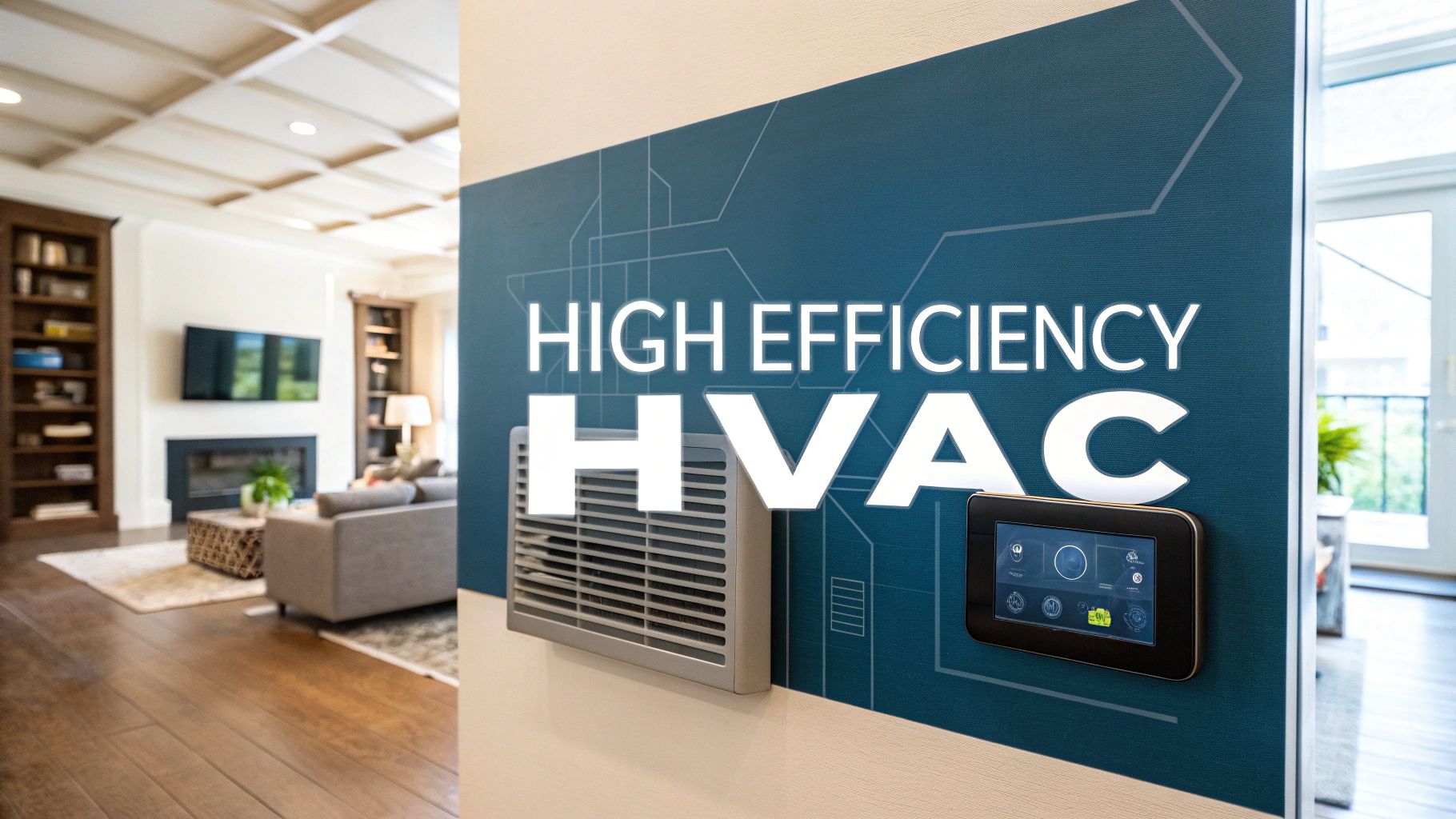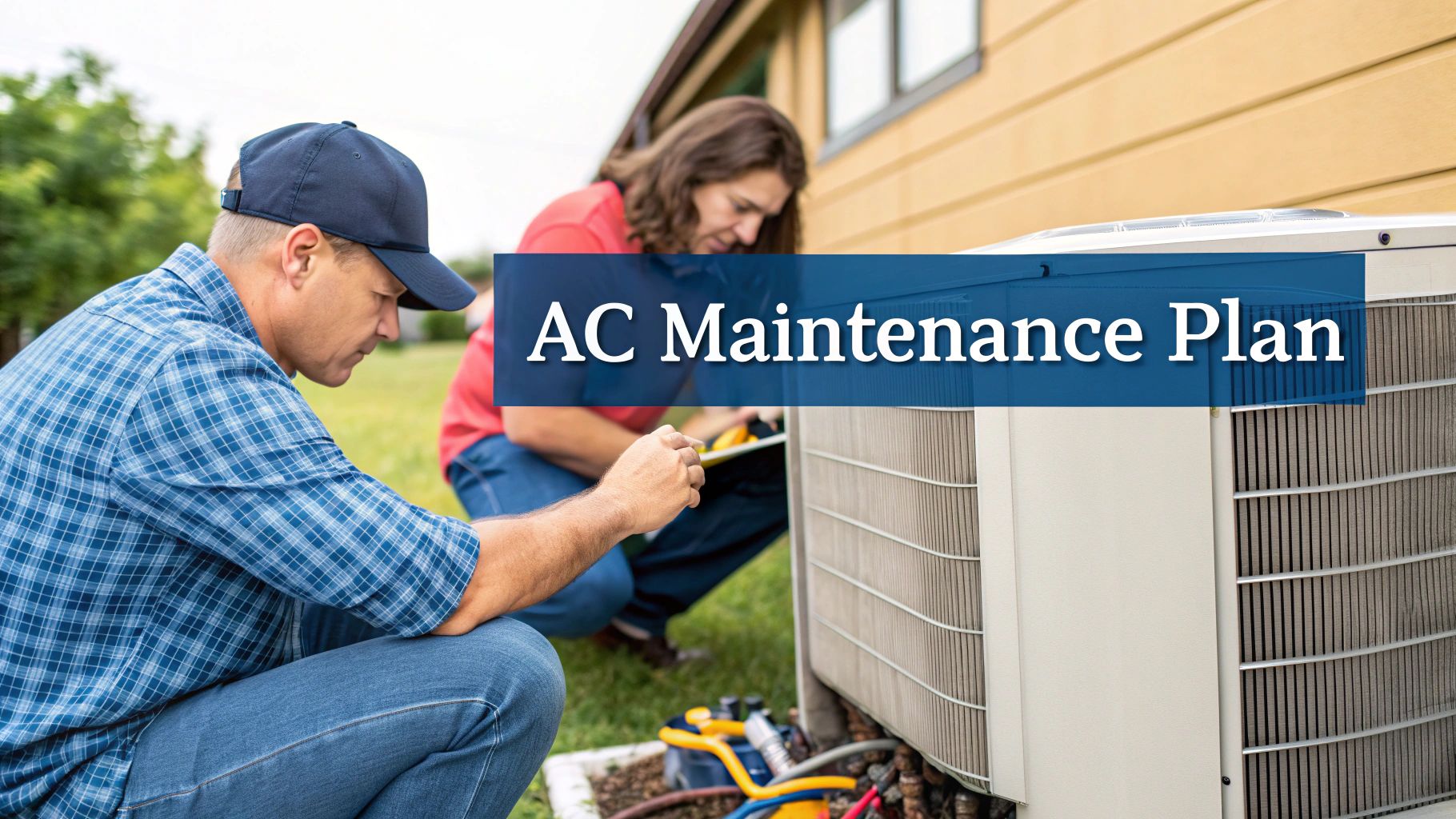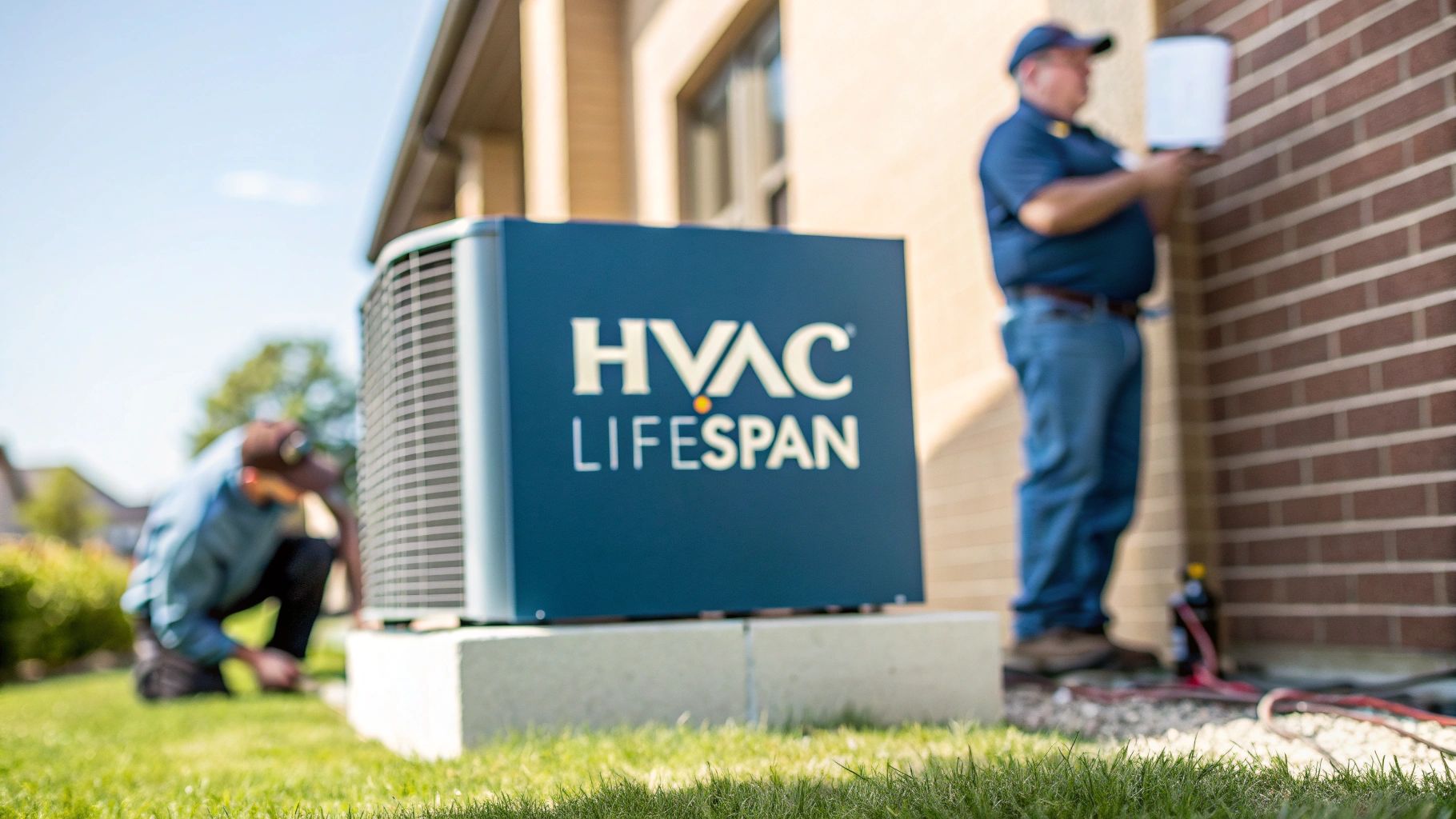A high-efficiency HVAC system is simply a smarter, more modern way to heat and cool your home. Instead of using a brute-force, all-or-nothing approach, these systems are engineered to provide incredible comfort while sipping, not gulping, energy. It’s a lot like comparing a gas-guzzling muscle car to a sophisticated modern hybrid—both get you there, but one does it with far more intelligence and efficiency.
The Secret to Smarter Comfort
At its heart, a high-efficiency system is all about precision. Older, standard HVAC units are what we call "single-stage." They only know two speeds: off and full blast. This constant cycling on and off is not only inefficient but also creates uncomfortable temperature swings throughout your home.
High-efficiency systems are different. They're designed to run for longer stretches but at much lower, more consistent speeds. This gentle, steady operation uses significantly less electricity and keeps your indoor temperature remarkably stable. As a bonus, avoiding those jarring starts and stops means less wear and tear on the system's most important parts, leading to a longer, healthier lifespan.
The Tech That Makes It Possible
So, what's under the hood that makes these systems so much better? It boils down to a few key engineering upgrades that leave decades-old designs in the dust.
- Variable-Speed Motors: Think of this as the brains of the blower. Instead of just flipping on and off, it intelligently adjusts its speed based on exactly how much heating or cooling is needed. This creates a quiet, even flow of air that gets rid of hot and cold spots and does a much better job controlling humidity.
- Multi-Stage or Modulating Compressors: The compressor is the engine of your AC. A multi-stage unit can run at different levels (say, 70% or 100%), while a top-of-the-line modulating compressor can make tiny adjustments anywhere from 40% to 100% capacity. This means your system uses only the precise amount of power required at any given moment.
- Smarter System Controls: Paired with a modern smart thermostat, these systems can actually learn the unique heating and cooling patterns of your house. They fine-tune their own performance to maximize efficiency and comfort.
Why It's More Than Just a Trend
The move toward high-efficiency home systems isn't just about keeping up with the Joneses; it's a real shift driven by homeowners wanting lower utility bills and new government standards. The numbers tell the story: the global HVAC market is booming, projected to grow from around USD 328.6 billion in 2025 to USD 577.5 billion by 2035, with a steady annual growth of 5.8%. According to a detailed HVAC market analysis, this growth is almost entirely fueled by the demand for smarter, energy-saving technology.
To make the difference crystal clear, let's break it down side-by-side.
Standard vs High Efficiency HVAC At a Glance
Here’s a quick look at how a traditional system stacks up against a modern high-efficiency model.
| Feature | Standard HVAC System | High-Efficiency HVAC System |
|---|---|---|
| Operation | "On" or "Off" only (single-stage) | Runs at various speeds (multi-stage/variable) |
| Energy Use | High, due to constant starts/stops | Low, runs steadily at lower power levels |
| Temperature Control | Noticeable temperature swings | Very consistent and even comfort |
| Humidity Control | Basic | Superior, removes more moisture from the air |
| Noise Level | Louder, especially on startup | Significantly quieter operation |
| Lifespan | Shorter, due to higher stress on parts | Longer, due to reduced wear and tear |
The comparison really highlights that you're not just buying a new air conditioner; you're upgrading the entire comfort experience in your home.
A high-efficiency unit isn’t just about being "green"—it's about smart resource management. By using less energy to achieve better results, you gain greater comfort, lower operational costs, and a more reliable system for years to come.
Ultimately, knowing what separates these systems from their older counterparts is the first step. It empowers you to make a smart investment in your home's comfort, one that pays for itself in lower bills and a better quality of life.
How to Decode Modern HVAC Energy Ratings
Trying to make sense of the specs on a new HVAC system can feel like learning a new language. You see acronyms like SEER2, EER2, and HSPF2 everywhere, but what do they really mean for your home here in Palm Beach County? Getting a handle on these ratings is the first step to making a smart, confident choice.
Think of it like shopping for a car. You wouldn't buy one without checking its MPG, right? HVAC ratings work the same way. One tells you about the system's long-term efficiency over a whole year, while another tells you how it holds up in the middle of a sweltering August afternoon. Together, they paint a complete picture.
SEER2: Your System's Yearly "MPG"
The rating you'll see most often is SEER2, which stands for Seasonal Energy Efficiency Ratio 2. This number basically tells you how much cooling the unit produces over an entire season compared to the electricity it uses to do it.
Bottom line? The higher the SEER2 rating, the more efficient the system is over the long run.
This infographic gives you a great visual breakdown of how advanced components—like the motor and compressor—all work together to achieve that higher efficiency.
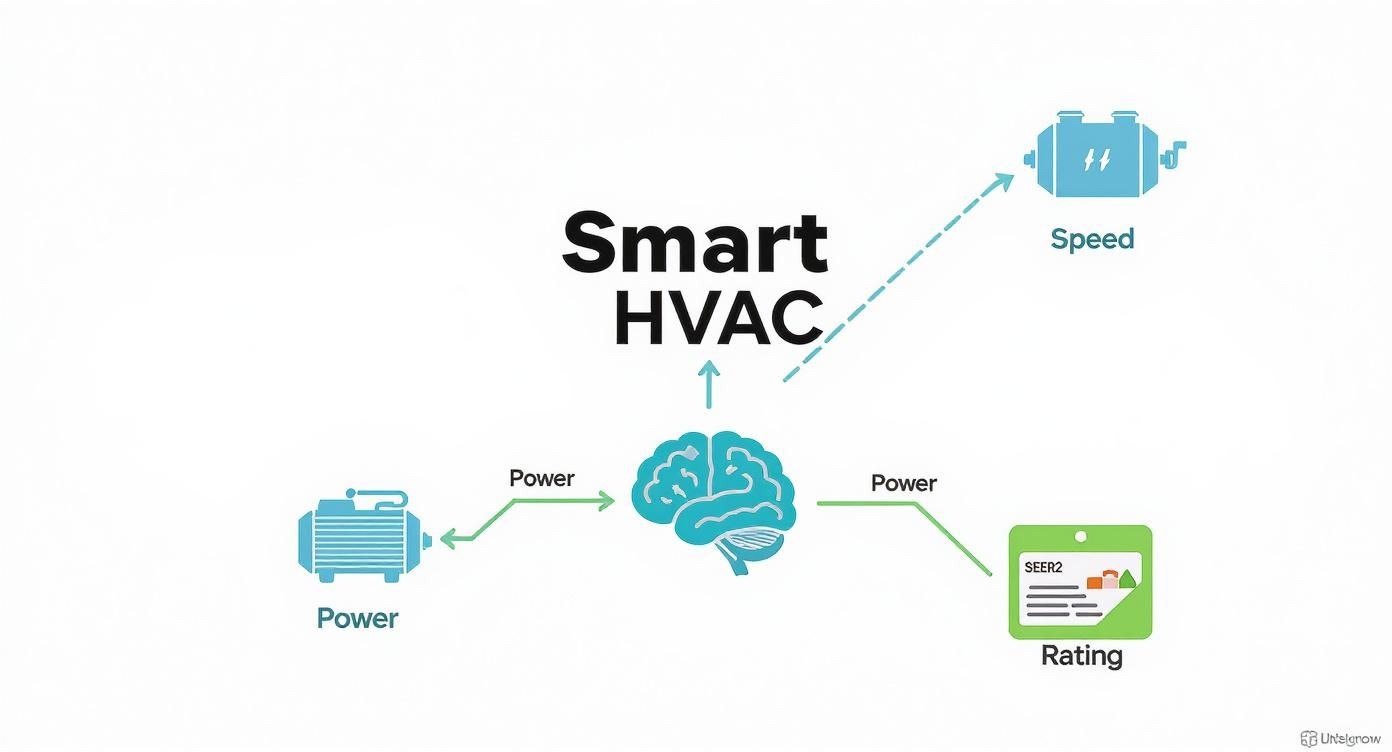
As you can see, a high SEER2 number isn't just about one part; it's the result of a smarter, more coordinated system designed to save energy.
EER2 and HSPF2: How It Performs When It Counts
While SEER2 gives you that big-picture view, other ratings get more specific about how a unit performs under particular conditions.
-
EER2 (Energy Efficiency Ratio 2): This is the unit’s efficiency score on a single, brutally hot day (95°F). For us in Florida, this number is a big deal. A high EER2 rating means your AC won't flinch during the most intense summer heatwaves.
-
HSPF2 (Heating Seasonal Performance Factor 2): This one is all about your heat pump's heating ability. It measures how efficiently it can warm your home during the cooler months. A higher HSPF2 means you’re getting more warmth for your energy dollar.
That little "2" you see in SEER2, EER2, and HSPF2 is a game-changer. It means the system was tested under the Department of Energy's tougher 2023 standards, which are designed to mimic real-world conditions in modern homes more accurately.
What Numbers Actually Mean "High-Efficiency"?
So, what should you be looking for on the label? The government sets the baseline, but a truly high-efficiency system will blow past those minimums.
Here in Florida and the rest of the Southeast, the current minimum is 14.3 SEER2. But if you're serious about efficiency, you'll want to look for models that start at 16 SEER2 and go all the way up to 26 SEER2 or higher. The best of the best often have the ENERGY STAR label, which is your guarantee of top-tier performance. If you want to learn more about what that certification involves, you can check out our guide on ENERGY STAR HVAC systems.
There’s a clear reason why these top-performing units are becoming so popular. The global market for energy-efficient HVACs is projected to grow at a rate of 10.7% each year, from a starting market size of USD 25.40 billion in 2025. People are more environmentally conscious than ever, and government efficiency rules are getting stricter.
At the end of the day, picking a system with higher ratings means you get lower monthly utility bills, better comfort, and a smaller carbon footprint. When you understand the numbers, you can look right past the sales pitch and choose an HVAC system that will deliver real, measurable value for years to come.
What Are the Real-World Benefits of Upgrading Your HVAC?
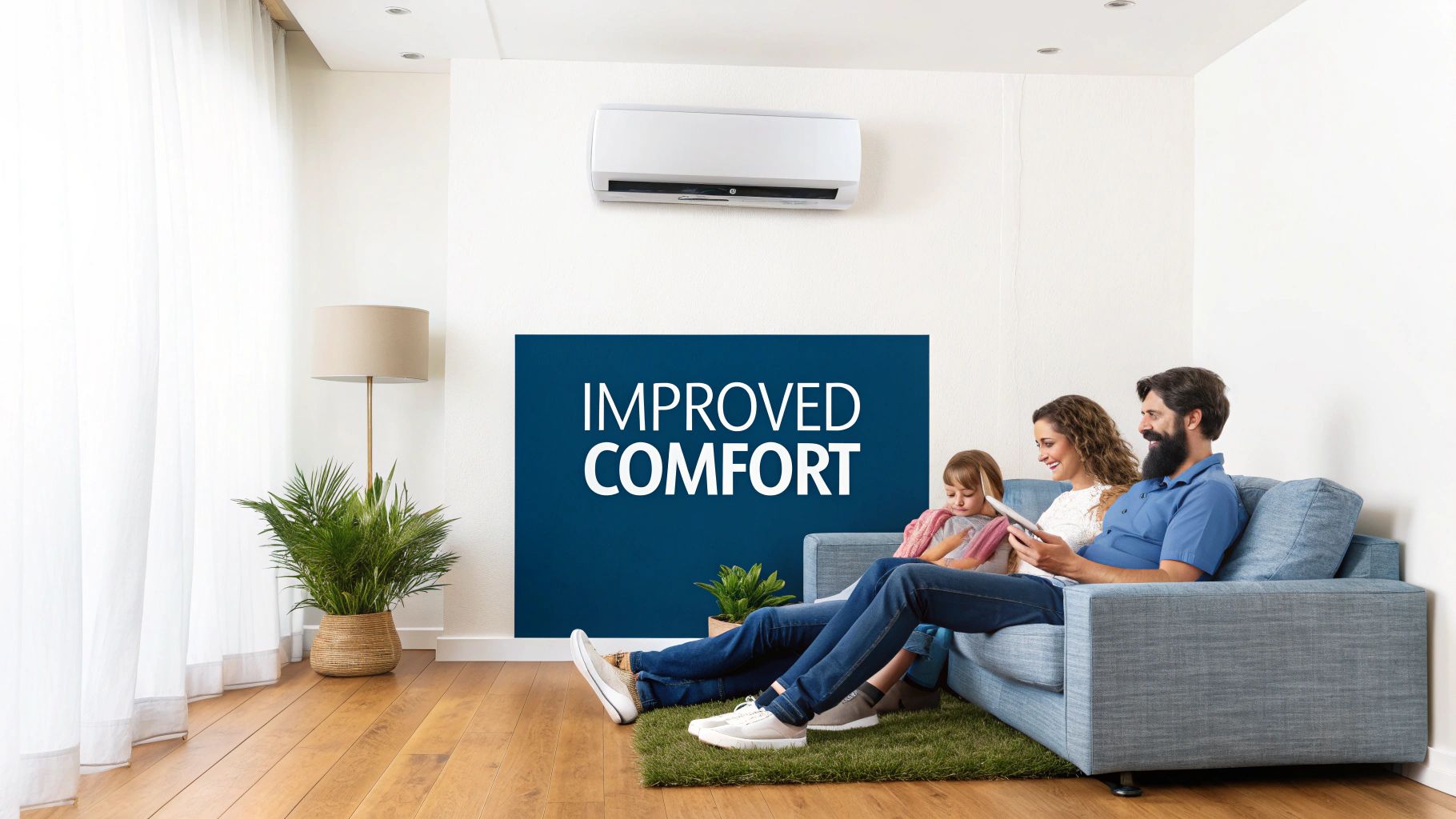
It’s one thing to understand the tech behind high-efficiency HVAC systems, but what does it all mean for your actual, day-to-day life? Forget the SEER2 ratings and fancy components for a moment. An upgrade brings real improvements you can see on your bills, feel in every room, and even hear (or not hear) throughout your home.
The most exciting and immediate perk is, of course, the money you’ll save. Switching out an old, energy-guzzling AC for a modern high-efficiency model can slash your monthly power bills. Your old unit is like a gas-guzzling car that only knows how to floor it; a new system is like a modern hybrid, sipping just enough energy to get the job done right.
This isn’t just pocket change, either. By upgrading to an ENERGY STAR-rated unit, most homeowners can save up to 20% on their annual heating and cooling costs. Over the years, that adds up to thousands of dollars back in your bank account, letting the new system essentially pay for itself.
Say Goodbye to Hot Spots and Humidity
While saving money is a huge win, the massive leap in comfort is where these systems truly prove their worth. They solve all those little annoyances you’ve probably just accepted as normal.
The magic lies in their variable-speed technology. Instead of the old "all-on" or "all-off" approach that blasts you with cold air and then shuts down, these systems run almost continuously at a very low, quiet speed. This gentle circulation keeps the air moving, wiping out those frustrating hot and cold spots from one room to the next.
This smarter operation is also a game-changer for humidity—our constant battle here in Palm Beach County. Because the system runs longer, it has more time to pull that sticky moisture out of the air. The result? Your home feels crisp and dry, making you feel more comfortable even when the thermostat is set a degree or two higher.
Imagine your home having the same perfect temperature in every single room. The air feels fresh, not damp, and your AC is so quiet you have to check if it's even on. That’s what it’s like living with a high-efficiency system.
A new HVAC is a powerful upgrade, and pairing it with additional strategies to reduce heating costs can take your home’s efficiency and comfort to the next level.
Built to Last, Not to Break Down
Think about the stress on an old system that’s constantly kicking on and shutting off. That jarring cycle puts a ton of wear and tear on the most important parts, like the compressor. It’s a fast track to breakdowns and a shorter lifespan.
High-efficiency systems are different. Their smooth, steady operation is much gentler on the internal components. This dramatically reduces mechanical stress, which means your unit is far more reliable and much less likely to quit on you during a sweltering summer afternoon.
This durability gives you two major advantages:
- Fewer Repair Calls: Less strain on the system means you’ll be seeing the repair tech a lot less often, saving you from surprise expenses.
- A Longer Lifespan: A well-cared-for high-efficiency system can reliably serve your home for 15 to 20 years, providing a much better return on your investment.
When it comes down to it, upgrading your HVAC is about more than just a new machine. It's a smart investment in your home's comfort, your wallet, and your peace of mind for years to come.
How to Choose the Right System for Your Home
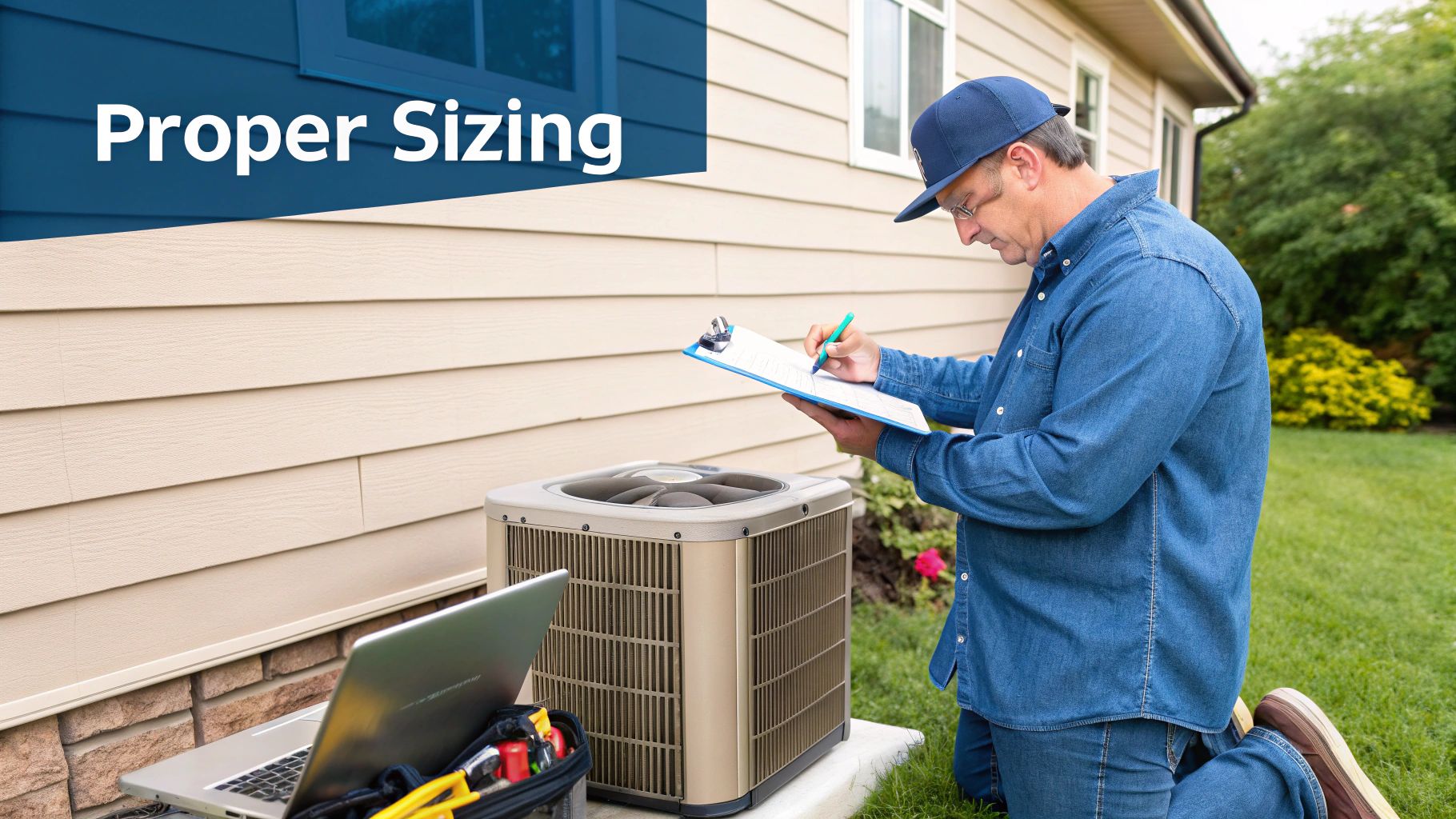
When it's time to pick a new high-efficiency HVAC system, it's easy to get fixated on the SEER2 rating. But the single most important decision you'll make has nothing to do with the number on the sticker. It’s all about getting the right size for your home.
Get this wrong, and you'll sabotage your savings from day one. A unit that's too big or too small won't just be inefficient; it will be a constant source of frustration.
It’s a common myth that a bigger, more powerful AC is always better. In reality, an oversized system is a recipe for disaster. It blasts your home with cold air so quickly that it shuts off before it can pull the sticky Florida humidity out of the air. The result? A room that feels cold and clammy at the same time. This constant on-and-off jarring, known as short-cycling, is also brutal on the compressor and can lead to a much shorter lifespan for your brand-new unit.
To sidestep this common mistake, a qualified pro needs to perform a detailed load calculation before you even look at models. This isn’t a quick guess based on square footage—it's a deep dive into your home's unique thermal personality.
Factors That Determine the Right Fit
A proper load calculation (often called a Manual J in the industry) looks at dozens of variables to make sure the recommended high efficiency HVAC systems are a perfect match.
A good technician will be looking at things like:
- Insulation Levels: How well do your walls and attic hold onto conditioned air?
- Window Quality: Are they old, single-pane windows that let heat pour in, or modern, efficient ones?
- Home Orientation: The direction your home faces dictates how much direct sun it gets slammed with all day.
- Local Climate: Here in Palm Beach County, the system needs to be a beast at handling both intense heat and oppressive humidity.
Nailing the size means your system will run smoothly and efficiently, keeping every room comfortable and humidity in check.
Your High-Efficiency HVAC Selection Checklist
Choosing a new system can feel overwhelming, but breaking it down helps. Use this checklist to guide your conversation with an HVAC professional and ensure you're covering all the bases.
| Consideration | What to Look For | Why It Matters |
|---|---|---|
| System Size | A professional Manual J load calculation. | Prevents short-cycling, ensures proper dehumidification, and maximizes efficiency. |
| SEER2/EER2 Ratings | Ratings that exceed current minimums (e.g., SEER2 of 17+). | Higher ratings mean lower monthly energy bills and a faster return on your investment. |
| Compressor Type | Variable-speed or two-stage compressors. | Offers superior comfort, quieter operation, and significant energy savings over single-stage models. |
| Smart Features | Wi-Fi connectivity, smart thermostat compatibility, and zoning options. | Provides greater control, convenience, and opportunities for additional energy savings. |
| Brand Reputation | Well-known brands with strong warranties and local parts availability. | Ensures long-term reliability and makes future repairs easier and more affordable. |
| Installer Quality | A licensed, insured, and reputable contractor with positive reviews. | A flawless installation is just as critical as the equipment for system performance and longevity. |
By thinking through these factors, you can move forward confidently, knowing you’re making a smart, informed decision for your home’s long-term comfort and efficiency.
Enhancing Efficiency with Smart Technology
Beyond the core unit, smart home integrations can squeeze even more savings and comfort out of your system. These aren't just gadgets for tech lovers anymore; they're essential tools for anyone serious about managing their home's climate and energy use.
This is the perfect time to think about upgrades like a zoning system. Zoning lets you set different temperatures for different areas of your house, so you're not paying to blast the AC in guest rooms you never use.
The push for high-efficiency systems is fueled by both a desire for lower bills and incredible leaps in technology. Smart controls are now at the heart of modern HVAC performance. It’s a global shift—countries like South Korea have widely adopted smart HVACs to cut energy use and improve air quality, a trend you can learn more about through market analysis on Grand View Research.
Why Professional Installation Is Non-Negotiable
Finally, remember this: you can buy the most advanced, perfectly sized system on the market, but if it's installed poorly, you've wasted your money. The quality of the installation is just as important as the quality of the unit itself.
A great technician makes sure every detail is perfect—ductwork is sealed tight, refrigerant levels are exact, and airflow is properly balanced. A sloppy install, on the other hand, can cause years of problems, kill your efficiency, and even void your warranty. Choosing a reputable, certified contractor is the most critical step in the entire process.
If your current system is acting up, knowing the warning signs that it's time for an HVAC replacement can help you figure out if now is the right time to make the switch.
Talking Money: The Cost and Return on Your HVAC Investment
Let's get straight to the point: yes, a high-efficiency HVAC system costs more upfront than a standard model. That initial price can give anyone a moment of pause, but looking at it as just another bill is the wrong way to think about it. It’s better to see it as a long-term investment—one that pays you back in more ways than one.
That higher sticker price is there for a reason. It accounts for the sophisticated technology packed inside, like variable-speed motors and multi-stage compressors that deliver amazing comfort and performance. But the real story isn't about what you spend today; it's about what you save for years to come. This is where your Return on Investment (ROI) kicks in, as those lower energy bills start to eat away at the initial cost month after month.
How Quickly Does It Pay for Itself?
Your ROI is simply the time it takes for the system's energy savings to cover its original price. You might be surprised how fast this can happen. Swapping out an old, clunky unit for a modern ENERGY STAR system can slash your heating and cooling costs by up to 20% every year.
Think of your old AC unit as a leaky bucket, constantly dripping money. A new high-efficiency system patches that hole, and all the money you were losing now stays in your pocket, adding up over the system's 15- to 20-year lifespan.
Let's make it real. A Palm Beach County homeowner who upgrades from a dusty 10 SEER unit to a new 18 SEER system will see a dramatic drop in their FPL bill. Those savings add up fast and shorten the payback period, making the upgrade a smart financial move. If you're curious about how these big projects are typically handled, looking into financing options for HVAC contractors can offer some great perspective.
Sweeten the Deal with Local Incentives
Living in Palm Beach County makes the deal even better. We have a great mix of local, state, and federal programs designed to make these energy-efficient upgrades much more affordable, which means your system pays for itself even faster.
These incentives can really add up:
- Federal Tax Credits: The federal government often rewards homeowners for going green with significant tax credits for installing qualifying high-efficiency systems. This isn't just a deduction; it's a direct reduction of your tax bill, potentially saving you thousands.
- Utility Rebates: Companies like Florida Power & Light (FPL) want you to use less energy, so they often offer cash rebates when you install an energy-efficient HVAC. This is cash back in your hand, lowering the net cost from day one.
- Manufacturer Promotions: Don't forget to check for deals from the brands themselves. HVAC manufacturers frequently run their own promotions and rebates on their best models, especially during certain times of the year.
When you stack all these savings together, that initial sticker price starts to look a lot less scary. A good local HVAC pro will know exactly which credits and rebates you’re eligible for and help you get every last dollar. It turns a necessary home repair into a savvy investment that boosts your comfort, shrinks your carbon footprint, and delivers a solid financial return for years.
Simple Maintenance to Maximize Performance
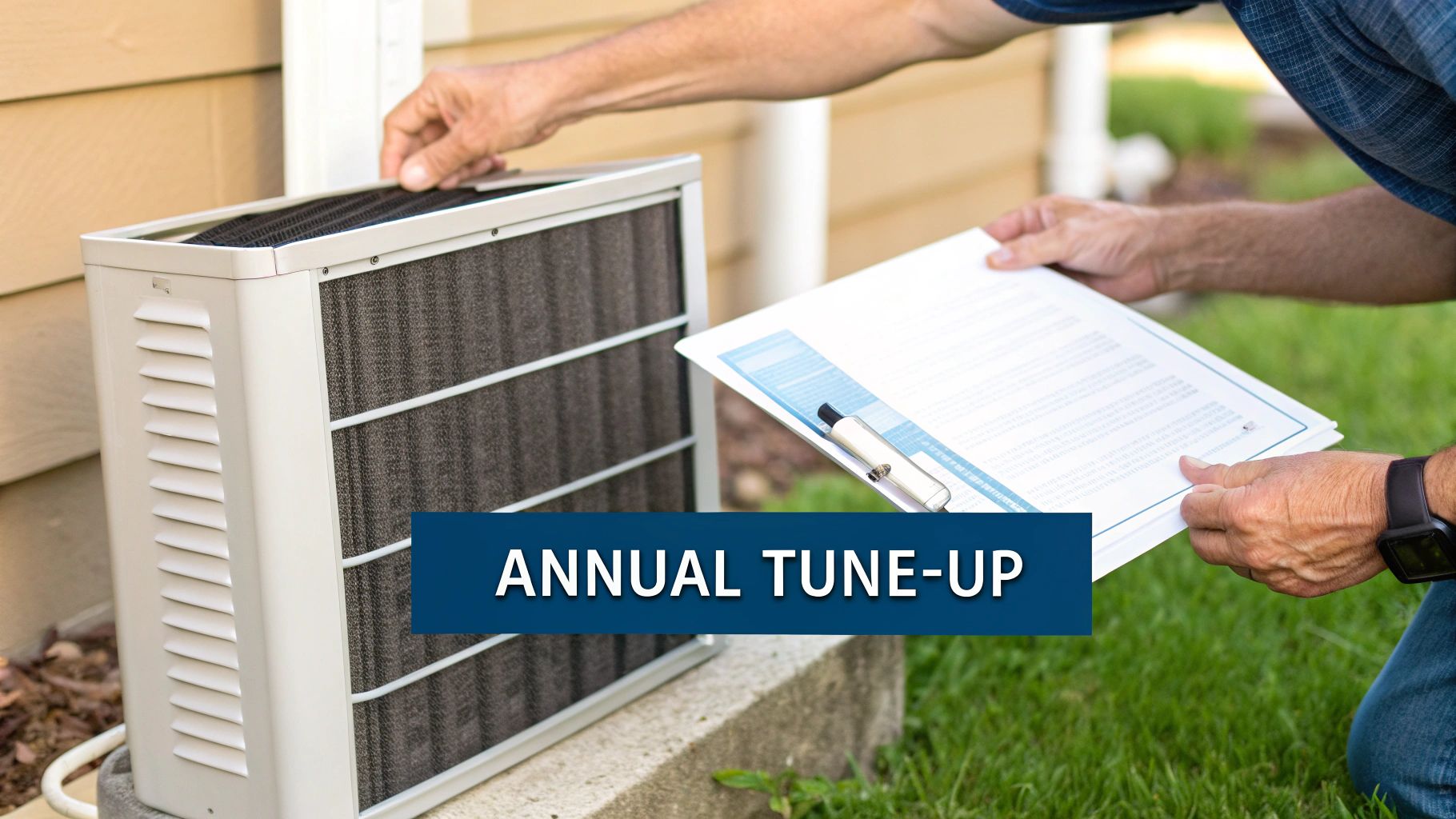
Think of your new high-efficiency HVAC system like a high-performance car. You wouldn’t skip oil changes and expect it to run perfectly, right? The same logic applies here. To get the incredible efficiency and reliability you invested in, a little regular care is essential.
A straightforward maintenance plan is the best way to protect that investment. The good news is that you don't have to be a pro to handle some of the most important jobs. A few simple tasks can prevent small issues from snowballing into expensive headaches.
Easy DIY Maintenance Tasks
Here are a couple of quick things you can do yourself to keep your system in top shape:
- Change Your Air Filter Monthly: This is the big one. A dirty, clogged filter chokes your system, forcing it to work overtime. This drives up energy bills and puts a ton of strain on the motor. Get in the habit of checking the filter every 30 days and swapping it out if it’s dirty.
- Keep the Outdoor Unit Clear: Your outdoor condenser unit needs room to breathe. Make a point to regularly clear away any leaves, grass clippings, or other debris that builds up around it. You want to maintain at least two feet of clearance on all sides for good airflow.
Think of your system’s annual tune-up as a crucial health check-up. A trained professional can spot hidden issues, optimize performance, and ensure every component is running safely and efficiently, preventing surprise breakdowns during the peak of summer.
The Importance of a Professional Tune-Up
While these DIY steps are a great start, they don't replace an annual professional tune-up. A certified technician has the tools and expertise to perform a much deeper check, making sure your high efficiency hvac systems are truly running at their peak. For more ideas on boosting your unit's performance, check out our guide on how to improve AC efficiency.
During a professional service visit, a technician will:
- Inspect and Clean Coils: Grime on the evaporator and condenser coils acts like a blanket, preventing them from transferring heat properly. This is a major efficiency killer.
- Check Refrigerant Levels: Too much or too little refrigerant can seriously damage the compressor and weaken your system's cooling ability.
- Test Electrical Components: A technician will tighten all electrical connections and test critical parts like capacitors to catch potential failures before they happen.
This yearly service is single-handedly the best thing you can do to maintain peak performance, extend your system's lifespan, and ensure it runs safely all year long.
Common Questions About High-Efficiency HVAC
Deciding to upgrade your HVAC system is a big deal, and it's smart to have questions before you dive in. We get asked a lot about high-efficiency systems, so we've put together some straightforward answers to the most common queries we hear from homeowners. Our goal is to help you feel confident about your decision.
Are These Systems Compatible With Older Homes?
Absolutely. We successfully install high-efficiency units in homes of all ages, from historic properties to houses built a few decades ago.
The real key isn't the age of your house, but the quality of the installation. This means making sure your existing ductwork is properly sized and sealed. A great system connected to leaky ducts will never perform at its best, so we always check that first.
Do They Need Special Maintenance?
They don’t need “special” maintenance, but they absolutely need consistent care to keep running at peak performance. Think of it like a high-performance car—you wouldn't skip its oil changes.
Sticking to a simple schedule of changing filters and getting an annual professional tune-up is the best way to protect your investment. If you let that slide, you'll start losing the very energy savings that made the system so attractive in the first place.
One of the biggest misconceptions is that a high-efficiency system is "set it and forget it." In reality, its performance is directly tied to regular, simple maintenance. Consistent care is what unlocks its long-term value.
How Much Quieter Are They, Really?
The difference is night and day. Older units have that loud, jarring "kick-on" and "shut-off" cycle. High-efficiency systems, on the other hand, use variable-speed motors and better insulation, allowing them to run at lower, steadier speeds.
Many homeowners are genuinely surprised by how peaceful their home becomes. You often don't even notice it's running—you just feel comfortable.
Are High-Efficiency Systems Worth It in Florida?
Yes, and they are especially valuable in our hot and humid climate. Here’s why: a high-efficiency unit is a master at dehumidification. Because it runs longer at lower speeds, it pulls significantly more moisture out of the air.
This makes your home feel much more comfortable, even at a slightly higher thermostat setting. That extra comfort and the ability to turn the temperature up a degree or two lead to even bigger energy savings during our long, sticky cooling season.
Here are a few final points to keep in mind:
- Lifespan: With proper maintenance, a high-efficiency system can easily last 15 to 20 years, often outliving standard models.
- Refrigerant: New systems use modern, environmentally safer refrigerants like R-410A, unlike older units that relied on coolants that are now being phased out.
- Smart Home Ready: Most high-efficiency models are built to work perfectly with smart thermostats, giving you total control over your home's comfort and energy use right from your phone.
Making the right choice for your home's comfort is crucial. The team at Florida Cooling Group is here to answer any other questions you have and help you find the perfect high-efficiency solution for your needs. Contact us today for a professional consultation.
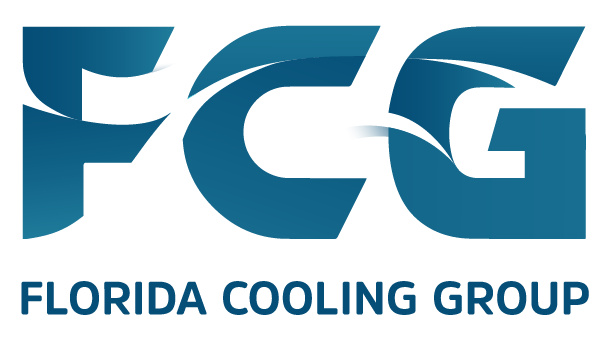
 (561) 400-2205
(561) 400-2205